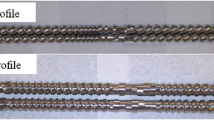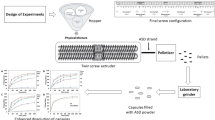Abstract
The objective of the current study was to develop an amorphous solid dispersion for a high melting point compound, griseofulvin (GRF), with an enhanced solubility and a controlled release pattern utilizing hot melt extrusion (HME) technology. Hypromellose acetate succinate (HPMCAS, Shin-Etsu AQOAT®, medium particle size) was explored as the polymeric carrier, while hypromellose (HPMC, Metolose® SR) was chosen as the release rate control agent. GRF presented an HPMCAS grade-dependent solubility: AS-HMP > AS-MMP > AS-LMP. At 10 wt.% loading, the release of GRF was prolonged to 6 h with the incorporation of 10% HPMC 90SH-100SR, while its solubility was enhanced up to sevenfold. Fourier transform infrared spectroscopy (FT-IR) identified the H-bonding between drug and polymers. Element analysis utilizing X-ray photoelectron spectroscopy (XPS) discovered that less GRF aggregated on the surface of binary powders compared with ternary powders containing HPMC, indicating the relatively poor wettability of the latter one. The morphology of extrudates was observed by scanning electron microscopy (SEM) and atomic force microscopy (AFM), illustrating a much smoother and uniform surface of binary extrudates. Immediate release tablets including 10% super-disintegrant L-HPC were able to achieve identical dissolution profile as the powders of extrudates.










Similar content being viewed by others
References
Shah S, Maddineni S, Lu J, Repka MA. Melt extrusion with poorly soluble drugs. Int J Pharm. 2013;453(1):233–52. doi:10.1016/j.ijpharm.2012.11.001.
Lu J, Cuellar K, Hammer NI, Jo S, Gryczke A, Kolter K, et al. Solid-state characterization of Felodipine-Soluplus amorphous solid dispersions. Drug Dev Ind Pharm. 2016;42(3):485–96. doi:10.3109/03639045.2015.1104347.
Sowa M, Ślepokura K, Matczak-Jon E. Improving solubility of fisetin by cocrystallization. CrystEngComm. 2014;46:10592–601.
Serajuddin AT. Salt formation to improve drug solubility. Adv Drug Deliv Rev. 2007;59(7):603–16. doi:10.1016/j.addr.2007.05.010.
Keen JM, Hughey JR, Bennett RC, Jannin V, Rosiaux Y, Marchaud D, et al. Effect of tablet structure on controlled release from supersaturating solid dispersions containing glyceryl behenate. Mol Pharm. 2015;12(1):120–6. doi:10.1021/mp500480y.
Brouwers J, Brewster ME, Augustijns P. Supersaturating drug delivery systems: the answer to solubility-limited oral bioavailability? J Pharm Sci. 2009;98(8):2549–72. doi:10.1002/jps.21650.
Rodriguez-Hornedo N, Murphy D. Significance of controlling crystallization mechanisms and kinetics in pharmaceutical systems. J Pharm Sci. 1999;88(7):651–60. doi:10.1021/js980490h.
Tran PH, Tran TT, Park JB, Lee BJ. Controlled release systems containing solid dispersions: strategies and mechanisms. Pharm Res. 2011;28(10):2353–78. doi:10.1007/s11095-011-0449-y.
Brown C, DiNunzio J, Eglesia M, Forster S, Lamm M, Lowinger M, et al. Hot-melt extrusion for solid dispersions: composition and design considerations. In: Shah N, Sandhu H, Choi DS, Chokshi H, Malick AW, editors. Amorphous solid dispersions: theory and practice. New York, Heidelberg, Dordrecht, London: Springer; 2014.
Noyes AA, Whitney WR. The rate of solution of solid substances in their own solutions. J Am Chem Soc. 1897;19(12):930–4.
Lu J, Obara S, Ioannidis N, Suwardie J, Gogos C, Kikuchi S. Understanding the processing window of hypromellose acetate succinate for hot-melt extrusion, part I: polymer characterization and hot-melt extrusion. Adv Polym Technol 2016. doi: 00, 21652, 10.1002/adv.21652.
Hughey JR, Keen JM, Brough C, Saeger S, McGinity JW. Thermal processing of a poorly water-soluble drug substance exhibiting a high melting point: the utility of KinetiSol® dispersing. Int J Pharm. 2011;419(1–2):222–30. doi:10.1016/j.ijpharm.2011.08.007.
Sarode AL, Obara S, Tanno FK, Sandhu H, Iyer R, Shah N. Stability assessment of hypromellose acetate succinate (HPMCAS) NF for application in hot melt extrusion (HME). Carbohydr Polym. 2014;101:146–53. doi:10.1016/j.carbpol.2013.09.017.
Karandikar H, Ambardekar R, Kelly A, Gough T, Paradkar A. Systematic identification of thermal degradation products of HPMCP during hot melt extrusion process. Int J Pharm. 2015;486(1–2):252–8. doi:10.1016/j.ijpharm.2015.04.007.
Crowley MM, Zhang F, Koleng JJ, McGinity JW. Stability of polyethylene oxide in matrix tablets prepared by hot-melt extrusion. Biomaterials. 2002;23(21):4241–8.
Al-Obaidi H, Brocchini S, Buckton G. Anomalous properties of spray dried solid dispersions. J Pharm Sci. 2009;98(12):4724–37. doi:10.1002/jps.21782.
Shah N, Iyer RM, Mair HJ, Choi DS, Tian H, Diodone R, et al. Improved human bioavailability of vemurafenib, a practically insoluble drug, using an amorphous polymer-stabilized solid dispersion prepared by a solvent-controlled coprecipitation process. J Pharm Sci. 2013;102(3):967–81. doi:10.1002/jps.23425.
DiNunzio JC, Brough C, Miller DA, Williams RO 3rd, McGinity JW. Fusion processing of itraconazole solid dispersions by kinetisol dispersing: a comparative study to hot melt extrusion. J Pharm Sci. 2010;99(3):1239–53.
Lakshman JP, Cao Y, Kowalski J, Serajuddin AT. Application of melt extrusion in the development of a physically and chemically stable high-energy amorphous solid dispersion of a poorly water-soluble drug. Mol Pharm. 2008;5(6):994–1002. doi:10.1021/mp8001073.
Verreck G, Decorte A, Li H, Tomasko D, Arien A, Peeters J, et al. The effect of pressurized carbon dioxide as a plasticizer and foaming agent on the hot melt extrusion process and extrudate properties of pharmaceutical polymers. J Supercrit Fluids. 2006;38(3):383–91.
Yalkowsky SH, Dannenfelser RM. Aquasol database of aqueous solubility. College of Pharmacy, University of Arizona, Tucson, AZ. 1992.
Hancock BC, Parks M. What is the true solubility advantage for amorphous pharmaceuticals? Pharm Res. 2000;17(4):397–404.
Chiou WL, Riegelman S. Preparation and dissolution characteristics of several fast-release solid dispersions of griseofulvin. J Pharm Sci. 1969;58:1505–10.
Roine J, Kaasalainen M, Peurla M, Correia A, Araujo F, Santos HA, et al. Controlled dissolution of griseofulvin solid dispersions from electrosprayed enteric polymer micromatrix particles: physicochemical characterization and in vitro evaluation. Mol Pharm. 2015;12(7):2254–64. doi:10.1021/mp500787b.
Saito M, Ugajin T, Nozawa Y, Sadzuka Y, Miyagishima A, Sonobe T. Preparation and dissolution characteristics of griseofulvin solid dispersions with saccharides. Int J Pharm. 2002;249(1–2):71–9.
Bennett RC, Keen JM, Bi Y, Porter S, Dürig T, McGinity JW. Investigation of the interactions of enteric and hydrophilic polymers to enhance dissolution of griseofulvin following hot melt extrusion processing. J Pharm Pharmacol. 2015;67(7):918–38.
Sarode AL, Sandhu H, Shah N, Malick W, Zia H. Hot melt extrusion (HME) for amorphous solid dispersions: predictive tools for processing and impact of drug-polymer interactions on supersaturation. European journal of pharmaceutical sciences : official journal of the European Federation for Pharmaceutical. Sciences. 2013;48(3):371–84. doi:10.1016/j.ejps.2012.12.012.
Chen M, Lu J, Deng W, Singh A, Mohammed NN, Repka MA, et al. Influence of processing parameters and formulation factors on the bioadhesive, temperature stability and drug release properties of hot-melt extruded films containing miconazole. AAPS PharmSciTech. 2014;15(3):522–9. doi:10.1208/s12249-013-0029-z.
Park JB, Lim J, Kang CY, Lee BJ. Drug release-modulating mechanism of hydrophilic hydroxypropylmethylcellulose matrix tablets: distribution of atoms and carrier and texture analysis. Curr Drug Deliv. 2013;10(6):732–41.
Juluri A, Popescu C, Zhou L, Murthy RN, Gowda VK, P CK, et al. Taste masking of griseofulvin and caffeine anhydrous using Kleptose Linecaps DE17 by hot melt extrusion. AAPS PharmSciTech. 2016;17(1):99–105. doi:10.1208/s12249-015-0374-1.
Fell JT, Newton JM. The tensile strength of lactose tablets. J Pharm Pharmacol. 1968;20(8):657–9.
Mitra A, Li L, Marsac P, Marks B, Liu Z, Brown C. Impact of polymer type on bioperformance and physical stability of hot melt extruded formulations of a poorly water soluble drug. Int J Pharm. 2016;505(1–2):107–14. doi:10.1016/j.ijpharm.2016.03.036.
Ilevbare GA, Liu H, Edgar KJ, Taylor L. Understanding polymer properties important for crystal growth inhibition-impact of chemically diverse polymers on solution crystal growth of ritonavir. Cryst Growth Des. 2012;12(6):3133–43.
Ueda K, Higashi K, Yamamoto K, Moribe K. The effect of HPMCAS functional groups on drug crystallization from the supersaturated state and dissolution improvement. Int J Pharm. 2014;464(1–2):205–13. doi:10.1016/j.ijpharm.2014.01.005.
Friesen DT, Shanker R, Crew M, Smithey DT, Curatolo WJ, Nightingale JA. Hydroxypropyl methylcellulose acetate succinate-based spray-dried dispersions: an overview. Mol Pharm. 2008;5(6):1003–19. doi:10.1021/mp8000793.
Morott JT, Pimparade M, Park JB, Worley CP, Majumdar S, Lian Z, et al. The effects of screw configuration and polymeric carriers on hot-melt extruded taste-masked formulations incorporated into orally disintegrating tablets. J Pharm Sci. 2015;104(1):124–34. doi:10.1002/jps.24262.
Feng X, Vo A, Patil H, Tiwari RV, Alshetaili AS, Pimparade MB, et al. The effects of polymer carrier, hot melt extrusion process and downstream processing parameters on the moisture sorption properties of amorphous solid dispersions. J Pharm Pharmacol. 2016;68(5):692–704. doi:10.1111/jphp.12488.
Lu J, Shah S, Jo S, Majumdar S, Gryczke A, Kolter K, et al. Investigation of phase diagrams and physical stability of drug-polymer solid dispersions. Pharm Dev Technol. 2015;20(1):105–17. doi:10.3109/10837450.2014.949269.
Schilling SU, Shah NH, Malick AW, Infeld MH, McGinity JW. Citric acid as a solid-state plasticizer for Eudragit RS PO. J Pharm Pharmacol. 2007;59(11):1493–500. doi:10.1211/jpp.59.11.0005.
Schilling SU, Lirola HL, Shah NH, Waseem Malick A, McGinity JW. Influence of plasticizer type and level on the properties of Eudragit S100 matrix pellets prepared by hot-melt extrusion. J Microencapsul. 2010;27(6):521–32. doi:10.3109/02652048.2010.484105.
Ghebremeskel AN, Vemavarapu C, Lodaya M. Use of surfactants as plasticizers in preparing solid dispersions of poorly soluble API: selection of polymer-surfactant combinations using solubility parameters and testing the processability. Int J Pharm. 2007;328(2):119–29. doi:10.1016/j.ijpharm.2006.08.010.
Ma D, Djemai A, Gendron CM, Xi H, Smith M, Kogan J, et al. Development of a HPMC-based controlled release formulation with hot melt extrusion (HME). Drug Dev Ind Pharm. 2013;39(7):1070–83. doi:10.3109/03639045.2012.702350.
Kunze C, Freier T, Kramer S, Schmitz KP. Anti-inflammatory prodrugs as plasticizers for biodegradable implant materials based on poly(3-hydroxybutyrate). J Mater Sci Mater Med. 2002;13(11):1051–5.
Schram CJ, Beaudoin SP, Taylor LS. Impact of polymer conformation on the crystal growth inhibition of a poorly water-soluble drug in aqueous solution. Langmuir. 2015;31(1):171–9. doi:10.1021/la503644m.
Marks JA, Wegiel LA, Taylor LS, Edgar KJ. Pairwise polymer blends for oral drug delivery. J Pharm Sci. 2014;103(9):2871–83. doi:10.1002/jps.23991.
Craig DQ. The mechanisms of drug release from solid dispersions in water-soluble polymers. Int J Pharm. 2002;231(2):131–44.
Ohara T, Kitamura S, Kitagawa T, Terada K. Dissolution mechanism of poorly water-soluble drug from extended release solid dispersion system with ethylcellulose and hydroxypropylmethylcellulose. Int J Pharm. 2005;302(1–2):95–102. doi:10.1016/j.ijpharm.2005.06.019.
Tanaka N, Imai K, Okimoto K, Ueda S, Tokunaga Y, Ibuki R, et al. Development of novel sustained-release system, disintegration-controlled matrix tablet (DCMT) with solid dispersion granules of nilvadipine (II): in vivo evaluation. Journal of controlled release : official journal of the controlled release. Society. 2006;112(1):51–6. doi:10.1016/j.jconrel.2006.01.020.
Gao P, Skoug JW, Nixon PR, Ju TR, Stemm NL, Sung KC. Swelling of hydroxypropyl methylcellulose matrix tablets. 2. Mechanistic study of the influence of formulation variables on matrix performance and drug release. J Pharm Sci. 1996;85(7):732–40. doi:10.1021/js9504595.
Crowley MM, Schroeder B, Fredersdorf A, Obara S, Talarico M, Kucera S, et al. Physicochemical properties and mechanism of drug release from ethyl cellulose matrix tablets prepared by direct compression and hot-melt extrusion. Int J Pharm. 2004;269(2):509–22.
Venkatesh GM, Barnett ME, Owusu-Fordjour C, Galop M. Detection of low levels of the amorphous phase in crystalline pharmaceutical materials by thermally stimulated current spectrometry. Pharm Res. 2001;18(1):98–103.
Zhao Y, Truhlar DG. The M06 suite of density functionals for main group thermochemistry, thermochemical kinetics, noncovalent interactions, excited states, and transition elements: two new functionals and systematic testing of four M06-class functionals and 12 other functionals. Theor Chem Accounts. 2008;120(1):215–41.
Dahlberg C, Millqvist-Fureby A, Schuleit M. Surface composition and contact angle relationships for differently prepared solid dispersions. Eur J Pharm Biopharm. 2008;70(2):478–85. doi:10.1016/j.ejpb.2008.05.026.
Prasad D, Chauhan H, Atef E. Role of molecular interactions for synergistic precipitation inhibition of poorly soluble drug in supersaturated drug-polymer-polymer ternary solution. Mol Pharm. 2016;13(3):756–65. doi:10.1021/acs.molpharmaceut.5b00655.
Wegiel LA, Mauer LJ, Edgar KJ, Taylor LS. Crystallization of amorphous solid dispersions of resveratrol during preparation and storage: impact of different polymers. J Pharm Sci. 2013;102(1):171–84. doi:10.1002/jps.23358.
Iyer R, Hegde S, Zhang YE, Dinunzio J, Singhal D, Malick A, et al. The impact of hot melt extrusion and spray drying on mechanical properties and tableting indices of materials used in pharmaceutical development. J Pharm Sci. 2013;102(10):3604–13. doi:10.1002/jps.23661.
Author information
Authors and Affiliations
Corresponding author
Ethics declarations
Conflict of Interest
The authors declare that they have no conflict of interest.
Rights and permissions
About this article
Cite this article
Lu, J., Obara, S., Liu, F. et al. Melt Extrusion for a High Melting Point Compound with Improved Solubility and Sustained Release. AAPS PharmSciTech 19, 358–370 (2018). https://doi.org/10.1208/s12249-017-0846-6
Received:
Accepted:
Published:
Issue Date:
DOI: https://doi.org/10.1208/s12249-017-0846-6




